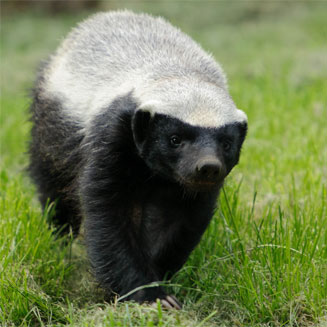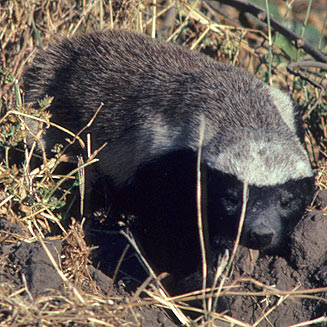|
Mellivora capensis (Honey badger)
ratel [Afrikaans]; Honigdachs
[German];
ratel [French];
nyegere [Swahili];
ulinda [isiNdebele];
insele [isiZulu] [siSwati];
magôgê [Sesotho];
matshwane, magôgô, magôgwê, magogwe, magwagwê [Setswana];
sere, tsere [Shona];
xidzidzi [Xitsonga];
tshiselele
[Tshivenda];
sikape [Lozi];
umbuli [Yei];
|Harebab, |Hareseb [Nama, [Damara]
Life
>
Eukaryotes >
Opisthokonta >
Metazoa (animals) > Bilateria > Deuterostomia >
Chordata > Craniata > Vertebrata (vertebrates) >
Gnathostomata (jawed vertebrates) > Teleostomi (teleost
fish) > Osteichthyes (bony fish) > Class:
Sarcopterygii (lobe-finned fish) > Stegocephalia
(terrestrial vertebrates) > Reptiliomorpha > Amniota >
Synapsida (mammal-like reptiles) > Therapsida > Theriodontia
> Cynodontia > Mammalia (mammals)
> Placentalia (placental mammals) > Laurasiatheria
> Ferungulata > Ferae > Carnivora > Family:
Mustelidae > Subfamily: Mellivorinae
 |
 |
|
Honey badger in captivity in the Howletts Wild
Animal Park, United Kingdom. [photo
Tom Enticknap ©] |
Honey badger. [photo Norman Larsen ©] |
Derivation of name
The common name of honey badger originates from
the behaviour of raiding beehives, natural and man-made, to eat the
honey and the larvae. Their other common name is “Ratel” which is
Afrikaans for rattle or honeycomb.
Identification
The honey badger has a stocky thickset body. It
has striking colouration with a silver-grey mantle that extends from
ear to ear over the top of the head, widening over the back and
narrows to a point at the base of the tail. The sides, limbs and
underparts are pure black. The top of the head and the neck are
whiter than the other markings. The short bushy black tail is often
held erect while the animal is trotting along. The ears are small
and hardly noticeable on the side of the head. The long heavy claws
on the forefeet are shaped like curved knives, an adaptation to
climbing and digging. The claws on the hindfeet are shorter and
broader. The skin is very thick and loose. It is reported that if a
honey badger is held in a grip by a predator it is able to turn
around and bite in defense. Like other mustelids they have a pair of
anal glands that excrete a foul smelling fluid in defense. The bone
of the skull is very thick and heavy.
Size
Total length 90 – 100 cm; shoulder height
30 cm; weight range 8 – 14 kg.
Dental Formula
I C C P P M M =
32 =
32
Distribution and habitat
Found in a wide variety of habitats throughout
most of southern Africa, but does not occur in the Free State and
along the west coast including the Namibian coastline.
General behaviour
Mainly nocturnal the honey badger may be active
in the early morning and late afternoon in less disturbed areas.
They are regarded tough, fearless and aggressive. When threatened by
much larger animals they will often retaliate and chase off
predators as large as lion. Honey badgers are skilled tree climbers
and nest raiders (chicks and eggs) and have to learn this behaviour
from their mother as it is not an inherited instinct. They shelter
in crevices in rocky areas, but are powerful diggers and can dig
their own refuges or modify existing unoccupied burrows, like
aardvark dens
Food
The honey badger is a generalist and has a wide
variety of food but insects, other invertebrates, rodents and
reptiles are the most important. Also eats fruit and carrion.
The honey badger is well-known for its foraging
association with a small bird, the honeyguide. These birds can find
the nests of wild bees but cannot break into the hive. They have a
distinctive song that they use to attract a honey badger to the hive
and wait for the hive to be opened for them. Once the badger has
eaten the honey and larvae that it wants from the hive the bird eats
the larvae and wax. Recent studies in the Kalahari have shown that
the honey badger digs out 85% of its prey. Larger prey especially
snakes make up over 50% of the prey eaten. It is a highly skilled
hunter and bites the head off snakes, seeming to be immune to their
toxic venom. Leopards and lions sometimes hunt honey badgers
Reproduction
Gestation period is about 180 days. A litter of
1 – 2 cubs are born in a burrow lined with grass and leavers.
Females are seldom seen with more than one cub, occasionally two.
The cubs are blind and naked at birth and development is very slow.
They only start to see at about 2.5 months and hear at about 3
months. At this stage they will emerge from the burrow. Young are a
rusty brown colour on their upperparts. It takes up to a year before
a cub can live independently from its mother. Cubs spend almost 2
years with their mother learning skills and behaviour from her.
Total life span averages about 16 years.
Conservation
Honey badgers come into fatal conflict with
farmers as some individuals will kill poultry, sheep and goats.
However, it is their taste for honey that gets the honey badger into
trouble with bee keepers. In many areas it is now threatened with
extinction due to indiscriminate poisoning, death by gun or dog and
the extremely cruel gin trapping still practiced by farmers in the
hope of deterring them in their search for honey. There are,
however, several effective and cheap interventions which result in
the “badger proofing” of bee hives. These methods need to be
implemented to ensure that the badgers remain safe and that the
farmers don’t suffer economic losses. In South Africa a campaign to
promote the conservation of honey badgers recognises farmers that
invest in building hives that are badger proof. Their products carry
a logo indicating that the product is “Badger Friendly”. It is
important to support conservation initiatives like this where both
parties benefit, and actively seek out honey products from “Badger
Friendly” farmers”.
Text by Denise Hamerton |
